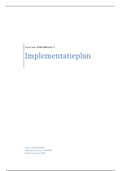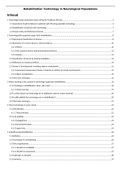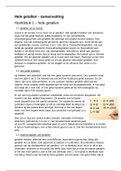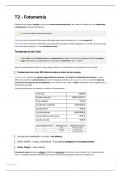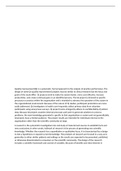Chapter 14. Capital structure in a perfect market
14.1 Equity versus debt financing
● Capital structure: The relative proportions of debt, equity, and other securities a firm
has outstanding
Financing a firm with equity
● Project cash flow → market risk → risk-free interest rate+risk premium →
calculate NPV
○ NPV represents the value to the initial wonders created by the project
● Unlevered equity: equity in a firm with no debt
Financing firm with debt and equity
● Levered equity: equity in a firm that also has debt outstanding
○ Promised payments to debt holders must be made before any payments to
equity holders are distributed
● With perfect capital markets, the total value of a firm should not depend on
its capital structure → firm’s total cash flow still equals the cash flow for the
project → same PV
○ Law of One Price gives the combined value of debt and equity, so the value of
the levered equity = combined value - debt value
● Cash flow levered equity < unlevered equity → levered equity will sell for a
lower price
○ Indifferent between capital structure as the raised money is the same
The effect of leverage on risk and return
● Leverage increases risk of equity of a firm
● Returns to equity holders are different with and without leverage
○ Levered equity → higher risk → higher expected return
, ● Formal way of evaluating the relationship between risk and return →
computing the sensitivity of each security’s return to the systematic risk of
the economy
○ Debt bears no systematic risk → risk premium is zero
● In the case of perfect capital markets:
○ Firm: 100% equity financed → equity holders require a 15% expected
return
○ Firm: financed with 50% debt +50% equity → debt holders receive a
return of 5% and equity holders will require a higher expected return of
25%
● Conclusion, leverage increases risk of equity even when there’s no risk of a firm’s
default
○ Debt may be cheaper, but raises the cost of capital for equity → ends
up being the same as unlevered
14.2 Modigliani-Miller I: Leverage, arbitrage, and firm value
● In 14.1, Law of One Price → leverage does not affect the total value of the
firm, just changes the allocation of cash flows debt <>equity → total cash
flow unaffected
● Modigliani and Miller (MM) → this results holds more generally under a set of
conditions:
● Conditions perfect capital markets:
○ Investors & firms can trade the same set of securities at competitive market
prices equal to the present value of their futura cash flows
○ There are no costs (taxes, transaction, or issuance) associated with security trading
○ A firm’s financing decisions do not change the cash flows generated by its
investments, nor do they reveal new information about them
● MM proposition I: in a perfect capital market, the total value of a firm’s securities is
equal to the market value of the total cash flows generated by its assets and is not
affected by its choice of capital structure
MM and the Law of One Price
● In absence of the costs: cash flow paid = cash flow generated by firm’s
assets → Law of One price: securities and assets have the same total market
14.1 Equity versus debt financing
● Capital structure: The relative proportions of debt, equity, and other securities a firm
has outstanding
Financing a firm with equity
● Project cash flow → market risk → risk-free interest rate+risk premium →
calculate NPV
○ NPV represents the value to the initial wonders created by the project
● Unlevered equity: equity in a firm with no debt
Financing firm with debt and equity
● Levered equity: equity in a firm that also has debt outstanding
○ Promised payments to debt holders must be made before any payments to
equity holders are distributed
● With perfect capital markets, the total value of a firm should not depend on
its capital structure → firm’s total cash flow still equals the cash flow for the
project → same PV
○ Law of One Price gives the combined value of debt and equity, so the value of
the levered equity = combined value - debt value
● Cash flow levered equity < unlevered equity → levered equity will sell for a
lower price
○ Indifferent between capital structure as the raised money is the same
The effect of leverage on risk and return
● Leverage increases risk of equity of a firm
● Returns to equity holders are different with and without leverage
○ Levered equity → higher risk → higher expected return
, ● Formal way of evaluating the relationship between risk and return →
computing the sensitivity of each security’s return to the systematic risk of
the economy
○ Debt bears no systematic risk → risk premium is zero
● In the case of perfect capital markets:
○ Firm: 100% equity financed → equity holders require a 15% expected
return
○ Firm: financed with 50% debt +50% equity → debt holders receive a
return of 5% and equity holders will require a higher expected return of
25%
● Conclusion, leverage increases risk of equity even when there’s no risk of a firm’s
default
○ Debt may be cheaper, but raises the cost of capital for equity → ends
up being the same as unlevered
14.2 Modigliani-Miller I: Leverage, arbitrage, and firm value
● In 14.1, Law of One Price → leverage does not affect the total value of the
firm, just changes the allocation of cash flows debt <>equity → total cash
flow unaffected
● Modigliani and Miller (MM) → this results holds more generally under a set of
conditions:
● Conditions perfect capital markets:
○ Investors & firms can trade the same set of securities at competitive market
prices equal to the present value of their futura cash flows
○ There are no costs (taxes, transaction, or issuance) associated with security trading
○ A firm’s financing decisions do not change the cash flows generated by its
investments, nor do they reveal new information about them
● MM proposition I: in a perfect capital market, the total value of a firm’s securities is
equal to the market value of the total cash flows generated by its assets and is not
affected by its choice of capital structure
MM and the Law of One Price
● In absence of the costs: cash flow paid = cash flow generated by firm’s
assets → Law of One price: securities and assets have the same total market


